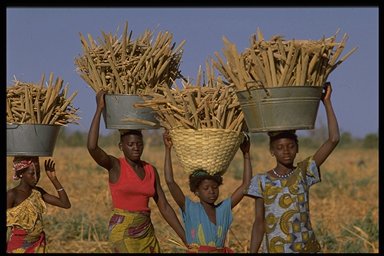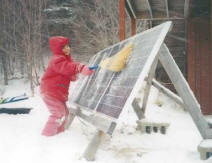Africa has had many stories of ethnic strife. One of the more recent involves the Sudan. Here, up to 2 million people are living in camps. These recent, high density accommodations place a high demand on nearby resources. Yet, this area isn’t empty. It already has many people of many ethnicities who want to maintain their lives as much as the new residents want just to survive.
The most recent news refers to interactions between these two groups. Women from the camps are searching for wood to cook. When they leave the camps they might get attacked (1). They need the energy of the wood to maintain their standard of living. This is a common practise in this part of Africa. But this wood is also needed by the indigenous population. Once the wood is gone, many years will pass before the wood regrows.
A camp in the Darfur is known to house 60,000 people. These people need 7.5e11 J/day or 0.75 terajoules of food. If there are five people in a family and each family needs a fire to cook the evening meal, there’d be 12000 fires a night. If a fire uses 1 kilogram of wood, a tiny amount, then each night needs 12000 kg. This represents 0.21 terajoules of energy each night. If a branch were to weigh 2.5 kg, a generous amount, these people would need 4800 branches every night. Assume a tree has 200 branches. Thus every night, 24 trees are completely consumed and most certainly 24 new trees don’t instantly appear. High concentrations of people require large quantities of fuel.
The first night, people gather fallen wood nearby. The second night the traverse a bit farther. By the second week, they’re using bark and dead branches off the living trees. Eventually, they walk kilometres to get fallen branches or cut down nearby living trees. This is the situation the campers experience. Travel far and risk attack or remain close but remove all the trees, never to replace them.
Though this is severe, this is not unusual. The grasping for fuel extends across Chad and Sudan. Without humans, the expected vegetation cover is aged, broadleaf deciduous trees. Instead there are young, thin short trees (2). Yet it is vegetation that gives the people their safety. Without the protection of trees, the Sahara remorselessly crawls south at about 10 km/yr.
Hence, the camps are a microcosm of the countries. People need wood for fuel and material. If they take more than can be sustainably replenished, they will doom their future. Perhaps Sudan and Chad represent a microcosm of humanity’s actions on Earth. We strive ever harder to acquire energy but in so doing we nullify our future.
Just imagine all the cities in the near North temperate climate (e.g. Chicago) when natural gas and petroleum are exhausted. Wood is the only practicable alternative. The first night there is plenty. By the first week, we are taking from the living trees. By the first decade, there may be no trees left to get energy, heat and what will us northerners then do?
(1) Attack
(2) Deforestation

 Continue reading “Darfur” →
Continue reading “Darfur” →











